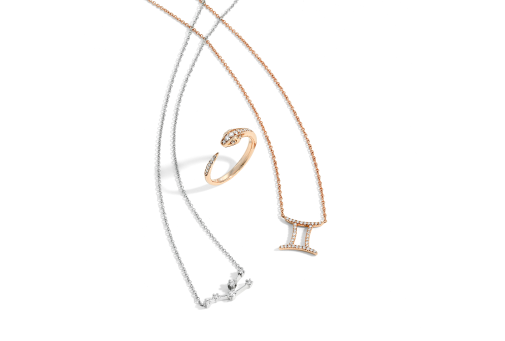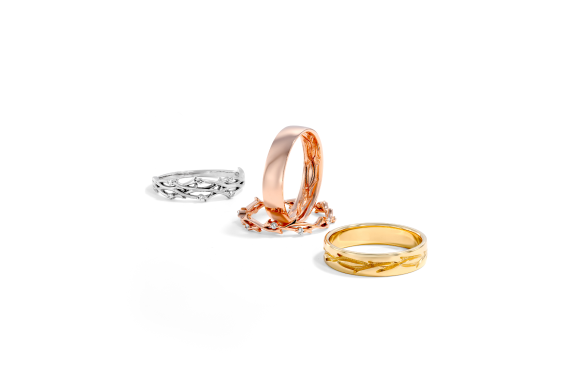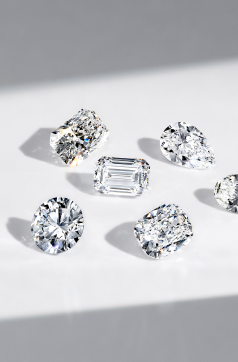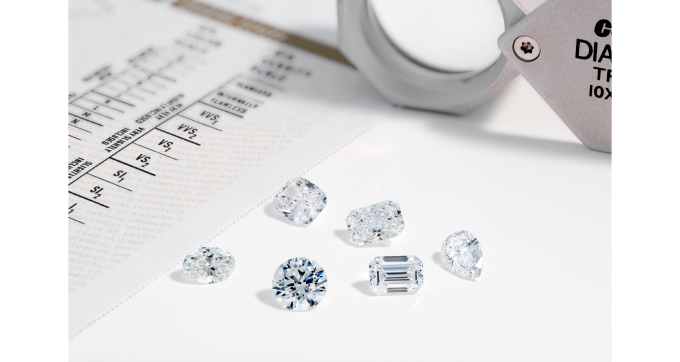Shapes - Asscher
Education Center
Education CenterEverything You Need to Know About Asscher Cut Diamonds
The Asscher’s bold lines and patterns have mesmerized people for over 120 years. The cut looks like something out of Great Gatsby-era America, with strong art deco vibes. Its large, clean facets give you a window into the center of your stone. There’s no other cut quite like the Asscher.
That being said, the Asscher isn’t for everyone. It looks smaller than other cuts; it requires exceptional clarity; it’s rare and expensive. Here’s our ultimate guide to the rare Asscher - and 3 reasons to avoid it and go for other diamond shapes.
What is an Asscher cut diamond?
The Asscher cut is quintessentially art deco: bold lines and geometric shapes. It has 58 facets, same as a modern round cut - but with very different geometry. Some call it the square cousin of the rectangular emerald cut because of its square dimensions and cropped edges.
The facets of Asscher cut diamonds are laid out in a square, step-cut pattern. This means they go down in “steps” instead of smooth, sloping angles. This makes the Asscher less brilliant than other cuts - but gives you a clean look into its center from all angles.
Asscher cut has a deep pavilion and a small table. It looks smaller but deeper than other cuts when viewed from above. It’s rare and hard to produce, with much material wasted in creating an Asscher. Fewer than 1 in 50 diamonds are cut in this shape.
|
Weight |
Width |
Height |
|
|
US Dime |
2.5 g |
17.91mm/0.705 inches |
17.91mm/0.705 inches |
|
1 carat round brilliant diamond |
0.2 g |
6.4 mm/0.251 inches |
6.4 mm/0.251 inches |
|
0.5 carat Asscher cut diamond |
0.1 |
4.3 mm/0.169 inches |
4.3 mm/0.169 inches |
|
1 carat Asscher cut diamond |
0.2 |
5.5 mm/0.217 inches |
5.5 mm/0.217 inches |
|
1.5 carat Asscher cut diamond |
0.3 |
6.5 mm/0.256 inches |
6.5 mm/0.256 inches |
|
2 carat Asscher cut diamond |
0.4 |
7.0 mm/0.276 inches |
7.0 mm/0.276 inches |
|
5 carat Asscher cut diamond |
1 g |
9.6 mm/0.378 inches |
9.6 mm/0.378 inches |
Table with the size of a US dime and Asscher cut stones
3 Reasons to Avoid an Asscher-Cut Stone
The 3 main reasons to avoid an Asscher-cut stone are…
Asschers Aren’t Sparkly
Most diamond shapes are made to maximize brilliance. Not the Asscher, though! This cut sacrifices sparkle for internal reflection and geometry. That’s why it’s called “an endless hallway with reflective mirrors” by jewelers.
An Asscher is still shiny, of course… But this shape is more about mesmerizing than dazzling.
Asschers Require Exceptional Cut & Clarity
An Asscher needs to have symmetry and clarity because you can see inside it so well. Strong tint will ruin its appearance. The same goes for a flawed cut. For an Asscher to look its best, it needs to have a cut grade of “ideal” or “excellent” - and a color grade of H or better.
The Asscher is rare and expensive to begin with. The cut and clarity grades required make good Asschers even more so. Plan on paying 10-20% more than you would for other fancy cuts.
Asschers Aren’t for Everyone
An Asscher isn’t like other stones; it’s half diamond and half fashion statement. If you’re not sure your significant other wants one, maybe don’t buy one. Its sharp lines and relative lack of brilliance aren’t for everyone!
History of the Asscher cut
The Asscher cut was invented in 1902 by Joseph Asscher of Amsterdam’s Royal Asscher Diamond Company. The cut’s popularity peaked when the art deco movement was in full swing in the 1920s. Streamlined, bold geometric shapes were all the rage… And the Asscher cut diamond fully embodied the art deco spirit.
After the 1920s, the Asscher lost much of its peak popularity for 80 years. This changed in 2002. That year, to mark the original Asscher’s centenary, the great grand-nephew of its creator invented a new version. This cut, called the Royal Asscher, was designed with 74 facets and a more modern look. This look became popular with younger generations of engagement ring shoppers - and has stayed that way since.
Is an Asscher cut diamond right for me?
An Asscher cut diamond’s clean, crisp lines and hypnotizing geometry make it an artistic statement piece. You’ll love it if you want some art deco sophistication in your life.
An Asscher is also a good choice if you want to show off your stone’s size, cut, and clarity. Its large facets mean you can see inside a stone - and if it’s clear and colorless, it’ll look like frozen water. The bigger the stone, the better the view.
Last but not least, Asscher cut diamonds are perfect for vintage ring settings. The vintage look is a natural fit with them because they were so popular 100-120 years ago.
How expensive are Asscher cut diamonds?
Asscher cut diamonds are more expensive than other fancy cuts but less expensive than the round brilliant. Some of the stone is lost to create the Asscher’s step-cut look, raising the cut’s price. Another factor is that slight flaws and tinting are highly visible in Asscher cut diamonds. Asscher stones need to be high in both clarity and color to look good - which means you end up paying more for them.
As of this writing, a quality 1-carat Asscher lab diamond will cost you $1,700-$2,100. An equivalent pear lab diamond will cost you $1,500-1,800.
A 1-carat Asscher natural diamond with high cut, clarity, and color can cost $3,000-$6,000. An equivalent cushion-cut natural diamond might run you $2,500-$5,500.
How to choose an Asscher cut diamond
Asscher cut diamonds have higher crowns than other shapes. They also have deeper pavilions. This gives them more depth and height than other shapes, shaping how you think about the 4 Cs when selecting a setting.
Cut
Asscher diamonds can be tricky to select based on cut. There are no widely accepted standards as to what makes a perfect one.
As a rule of thumb, you don’t want your stone to have too much depth. Depth eats into your carat weight, reducing the stone’s size.
Something else to look for is symmetry. You want your Asscher to be square and symmetrical. Without those, you’ll miss out on the stone’s trademark geometric patterns and forms.
Clarity
As step cut diamonds, Asscher cuts have fewer facets than their brilliant-cut counterparts. This makes impurities highly visible. Choose a diamond of VS2 clarity or higher to avoid seeing imperfections.
Color
Asscher cut diamonds have broad tables and large facets. Low color grades look more visibly tinted than with brilliant cuts. Look for a color grade of H or better. The larger your diamond is, the better its color needs to be.
Carat
Heavier Asscher cuts tend to look better. You can see their internal geometry in great detail. Just be mindful of two things. First, make sure your Asscher isn’t too deep; otherwise, you’re not benefiting from its carat weight. Second, bigger stones require higher clarity and color grades. You can see discoloration and flaws more easily in them.
What settings look best with an Asscher cut diamond?
A classic, simple solitaire setting will showcase your Asscher cut diamond and let the stone’s brilliance take center stage. On the other hand, adding a halo of smaller stones around your diamond can enhance its sparkle. If you want to make sure your wedding band fits flush against your diamond ring, consider a cathedral setting for your Asscher cut diamond.
How do I style my Asscher cut diamond ring?
Jewelry with art deco features like straight lines and bold geometric patterns will match your Asscher cut diamond’s style. Asscher cut diamond rings pair nicely with classic tennis bracelets and diamond stud earrings. You can also pair your Asscher ring with jewelry that features square, emerald, or Asscher cut diamonds.
Conclusion
When you choose an Asscher cut diamond, you get a sophisticated, brilliant gem. With a rich history and two varieties to choose from, Asschers make an excellent choice for many. Asscher cut diamonds are classic beauties that stand the test of time.
Asscher cut diamond FAQs
What cuts look similar to Asscher cut diamonds?
Emerald, radiant, and princess cuts are all similar to Asscher cut diamonds, but are distinct in their own ways.
Asscher vs. Emerald
Emerald cut stones are step cuts just like Asscher cuts. They are rectangular rather than square-shaped. Asscher cut diamonds give off more sparkle because they have better symmetry. Emerald cut diamonds appear larger because of their elongated shape.
Asscher vs. Radiant
Radiant cut diamonds and Asscher cut diamonds both have eight sides. Radiant cuts are cut for brilliance, with a crushed-ice look. They have more sparkle than Asscher cut stones but lack the same “hall of mirrors” quality.
Asscher vs. Princess
Princess cut diamonds have 4 sides and a square shape. Asscher cut diamonds have cropped corners and 8 sides. Asscher cut diamonds are step cuts; princess cut diamonds are brilliant cuts. Princess cut diamonds hide imperfections better, so you can get away with a lower color grade than you can with an Asscher.
Do Asscher cut diamonds look small?
Asscher cut diamonds tend to look smaller than other diamonds of the same carat weight. This is due to the depth of Asscher cut diamonds - a portion of their carat weight is “hidden” in that depth. Aim for a carat weight about one quarter more than you would for another cut.



